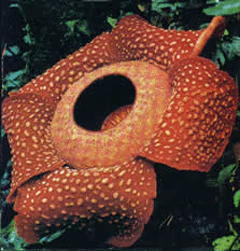Emerging Science Note/Stinky Bloom
Air Date: Week of January 19, 2007

The Rafflesia arnoldii (Photo: Harry Wiriadinata and Suwito Alam)
The rafflesia is both a flower and a parasite, with a rotting-flesh odor to boot. Meghan Vigeant reports.
Transcript
[SWARM OF INSECTS BUZZING]
VIGEANT: Layers of blotchy red flesh lie on the forest floor. A putrid odor rises attracting swarms of carrion flies. The flies think it’s an animal carcass. But it’s not. It’s a flower.
[SCIENCE NOTE THEME]
VIGEANT: It’s called the rafflesia, and it’s the world’s biggest and smelliest flower. The bizarre plant, grows in Indonesia and instead of a sweet smell it mimics a dead animal to attract pollinating insects. It’s always been thought to be something of an orphan. But researchers writing in the journal, Science say they’ve finally found the rafflesia’s true family. And it turns out one of its closest relatives is the beloved poinsettia. They’re both members of the Euphorbiaceae- or surge- family, which also includes such familiar favorites as Irish bells and rubber trees.

The Rafflesia arnoldii (Photo: Harry Wiriadinata and Suwito Alam)
And it’s an ancient family. The rafflesia dates back to the days of the dinosaurs, making it one of the first flowers on earth.
VIGEANT: While the dinos might be gone, this beastly flower is still stinking it up.
[SNIFFS]
VIGEANT: That’s this week’s note on emerging science, I’m Meghan Vigeant.
Living on Earth wants to hear from you!
Living on Earth
62 Calef Highway, Suite 212
Lee, NH 03861
Telephone: 617-287-4121
E-mail: comments@loe.org
Newsletter [Click here]
Donate to Living on Earth!
Living on Earth is an independent media program and relies entirely on contributions from listeners and institutions supporting public service. Please donate now to preserve an independent environmental voice.
NewsletterLiving on Earth offers a weekly delivery of the show's rundown to your mailbox. Sign up for our newsletter today!
 Sailors For The Sea: Be the change you want to sea.
Sailors For The Sea: Be the change you want to sea.
 The Grantham Foundation for the Protection of the Environment: Committed to protecting and improving the health of the global environment.
The Grantham Foundation for the Protection of the Environment: Committed to protecting and improving the health of the global environment.
 Contribute to Living on Earth and receive, as our gift to you, an archival print of one of Mark Seth Lender's extraordinary wildlife photographs. Follow the link to see Mark's current collection of photographs.
Contribute to Living on Earth and receive, as our gift to you, an archival print of one of Mark Seth Lender's extraordinary wildlife photographs. Follow the link to see Mark's current collection of photographs.
 Buy a signed copy of Mark Seth Lender's book Smeagull the Seagull & support Living on Earth
Buy a signed copy of Mark Seth Lender's book Smeagull the Seagull & support Living on Earth

